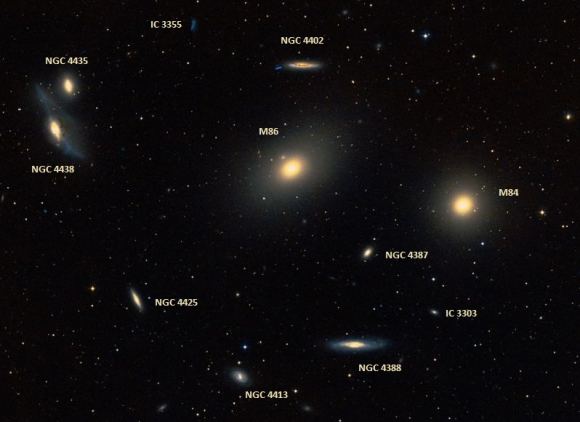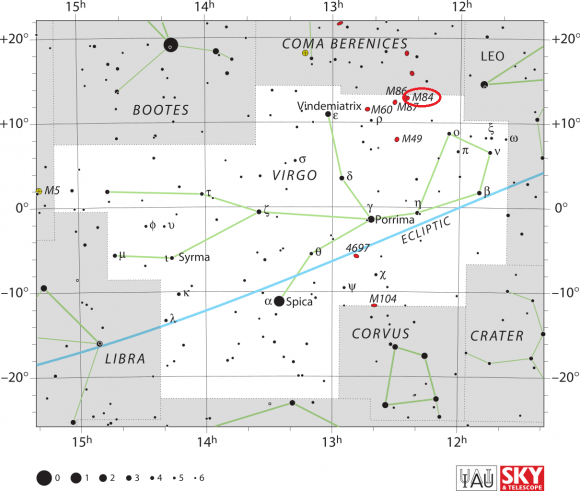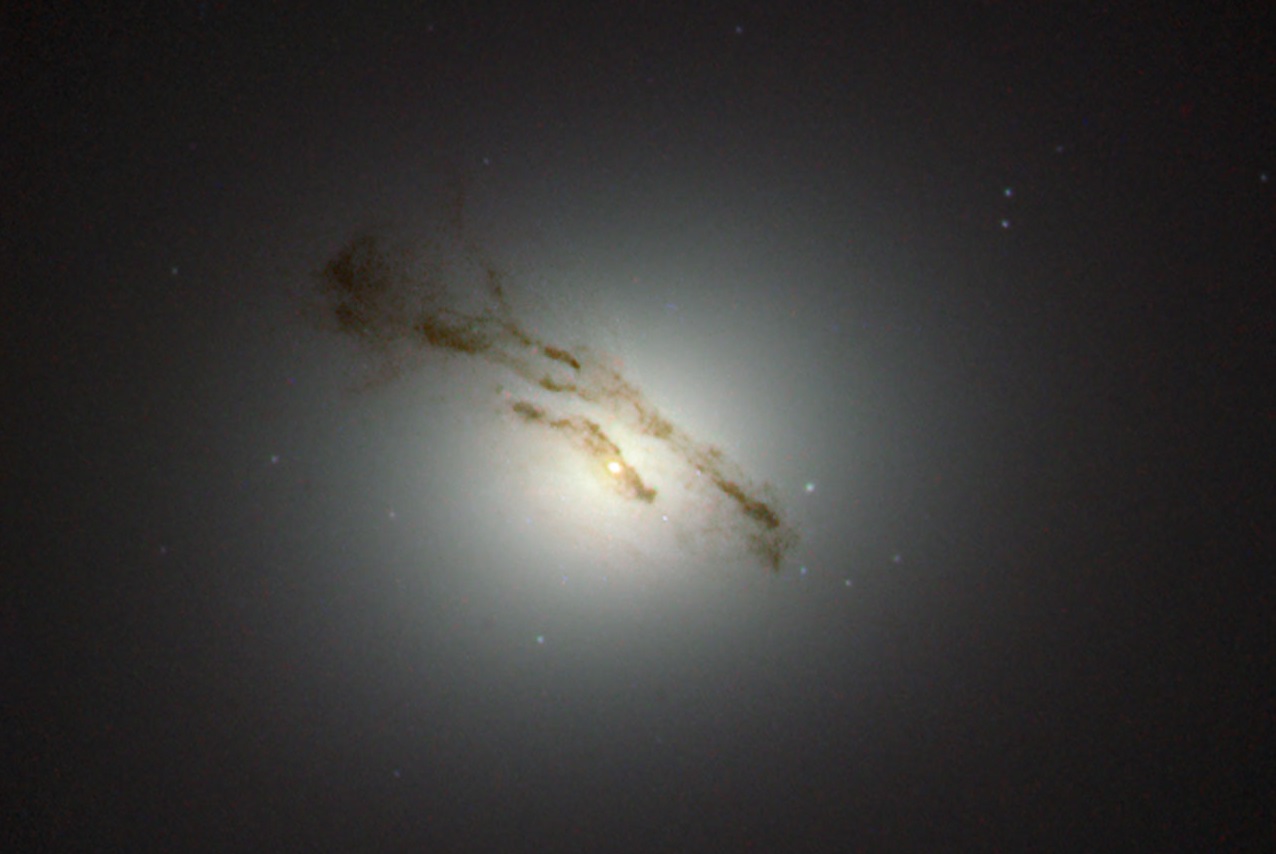Welcome back to Messier Monday! Today, we continue in our tribute to our dear friend, Tammy Plotner, by looking at the elliptical (lenticular) galaxy known as Messier 84!
During the 18th century, famed French astronomer Charles Messier noticed the presence of several “nebulous objects” while surveying the night sky. Originally mistaking these objects for comets, he began to catalog them so that others would not make the same mistake. Today, the resulting list (known as the Messier Catalog) includes over 100 objects and is one of the most influential catalogs of Deep Space Objects.
One of these objects is known as Messier 84, an elliptical (or lenticular) galaxy located about 54.9 million light years from Earth. This galaxy is situated in the inner core of the heavily populated Virgo Cluster and has two jets of matter shooting out of its center. It also has a rapidly rotating disk of gas and stars that are indicative of a supermassive black hole of 1.5 billion Solar masses at its center.
Description:
Somewhere in this huge conglomeration of globular clusters and older yellow stars, the nucleus of M84 contains a massive central object of 300 million solar masses, concentrated in less than 26 light years from the galaxy’s center. Jets of matter shoot out from the galaxy’s center and a disk of rapidly rotating gas and stars close to the nucleus suggest the presence of a supermassive black hole… But what is really there?
When the Hubble Space Telescope took a close look at 60 million light year distant M84 the Imaging Spectrograph captured a blitzkrieg spectrum which is indicative of a black hole. With particles whirling around at a velocity of 880,000 mph within 26 light years of the galactic center, chances are the black hole is supermassive – 1.5 billion times the size of our Sun. As G.A. Bower (et al) said in 1997 study:
“The presence of a nuclear gas disk in M84 is especially interesting. If the gas exhibits Keplerian motion about the nucleus, then a straightfoward application of Newton’s laws to the dynamics of this gas disk would provide an estimate of the mass of the putative supermassive black hole (BH) in M84’s nucleus.”
Later studies in different electromagnetic wavelengths provided a more interesting picture of M84. In a spectral composite which included information gathered by the Chandra X-Ray Observatory in 2000, hot gas is shown as blue. But that’s not all that’s here! Patterned in red is the radio image from the Very Large Array and yellow is the contribution of the Sloan Digital Survey is yellow.
Here revealed are white bubbles of gas blown outward by relativistic particles generated by super massive black holes and heating the surrounding gas. As A. Finoguenov (et al) indicated in a 2002 study:
“We find an excess in the number of sources centered on M84 with a spatial distribution closely corresponding to the M84 stellar light. Given an absence of recent star formation, accreting binaries are the only candidates for the M84 X-ray sources. The most luminous sources, which we attribute to accreting black holes, exhibit X-ray colors typical of a blackbody spectrum. We also identify the sources whose X-ray colors match the expectations for constituents of the cosmic X-ray background.”

The X-ray observation shows how the supermassive black hole at the center of the galaxy is lighting things up. The black hole has regular, repeated outbursts, heating the halo gases. As D.E.Harris (et al) revealed in a 2002 study:
“During the course of an investigation of the interaction of the radio galaxy M84 and its ambient cluster gas, we found excess X-ray emission aligned with the northern radio jet. The emission extends from the X-ray core of the host galaxy as a weak bridge and then brightens to a local peak coincident with the first detectable radio knot at ˜2.5″ from the core. The second radio knot at 3.3″ is brighter in both radio and X-rays. Although all the evidence suggests that Doppler favoritism augments the emission of the northern jet, it is unlikely that the excess X-ray emission is produced by inverse Compton emission. We find many similarities between the M84 X-ray jet and recent jet detections from Chandra data of low luminosity radio galaxies. For most of these current detections synchrotron emission is the favored explanation for the observed X-rays.”
History of Observation:
M84 was originally discovered and cataloged by Charles Messier on March 18, 1781 – along with several other members of the Virgo Galaxy Cluster. In his notes he writes: “Nebula without star, in Virgo; the center it is a bit brilliant, surrounded with a slight nebulosity: its brightness and its appearance resemble that of those in this Catalog, No.s 59 and 60.”
Although it would be many years before the nature of the galaxy cluster came to light, many historic astronomers simply didn’t “get” the significance of so many little nebulae together. But there was one astronomer who had a very open mind and knew there was something more there than met the eye… Sir William Herschel. As he wrote in his notes:
“The number of compound nebulae that have been noticed in the foregoing three articles [on multiple nebulae] being so considerable, it will follow, that it they owe their origin to the breaking up of some former extensive nebulosities of the same nature with those which have been shewn to exist at present, we might expect that the number of separate nebulae should far exceed the former, and that moreover these scattered nebulae should be found not only in great abundance, but also in proximity or continuity of each other, according to the different extents and situations of the former diffusions of such nebulous matter. Now this is exactly what by observation, we find to be the state of the heavens.”
Capture them tonight!

Locating Messier 84:
Messier 84 is located in the heavily populated inner core of the Virgo Cluster of galaxies about halfway between Epsilon Virginis and Beta Leonis. It is considered either a lenticular spiral seen face-on – or an eliptical, and it will show as its bright core and round form for a larger telescope and a small round smudge for smaller ones. It requires dark sky and a telescope to be seen.
And here are the quick facts on this Messier Object to help get you started:
Object Name: Messier 84
Alternative Designations: M84, NGC 4374
Object Type: SO Spiral Galaxy
Constellation: Virgo
Right Ascension: 12 : 25.1 (h:m)
Declination: +12 : 53 (deg:m)
Distance: 60000 (kly)
Visual Brightness: 9.1 (mag)
Apparent Dimension: 5.0 (arc min)
We have written many interesting articles about Messier Objects and globular clusters here at Universe Today. Here’s Tammy Plotner’s Introduction to the Messier Objects, M1 – The Crab Nebula, Observing Spotlight – Whatever Happened to Messier 71?, and David Dickison’s articles on the 2013 and 2014 Messier Marathons.
Be sure to check out our complete Messier Catalog. And for more information, check out the SEDS Messier Database.
Sources:

